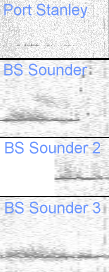
|
The sounder at Port Stanley. About 10 days worth of chirps showing
nicely the drift of the sounder (from top to bottom). The only
chirps in the left part, are probably due to sporadic E-layer
propagation.
 |
 |
A montage of the chirps of the BS sounders in the US, at the same time
of the Es propagation of above. The plots are correctly positioned in
time - I detected Sounder 2 quite a bit later. Also note that the
first sounder 'wandered off' at the end of its trace.
|

|
At least one of the BS sounders seems to 'move slowly' from one
frequency to another, changing around 20ms per 12-minute cycle...
 |

|
... though the movement is not always constant, as shown here.
These two plots were horizontally scaled 8 times to show off the
chirps
 |

|
This is a collage of several waterfall plots, to obtain a total range of
600ms. It's scaled horizontally to enhanced the chirps. It's possible to
note that though the chirper does move constantly in the same direction,
it does sometimes change back suddenly and then continues.
Also note that this was taken on the Backscatter 'jump' frequency, so
there are actually two chirps visible at each time interval. 15978.5 kHz
 |

|
Another collage near where the BS sounders start their scan (5MHz).
Measured at 5078.5 kHz
 |

|
This is a BS sounder, recorded at the exact moment it 'jumps' in time.
(This happens each 20 kHz). So the lower trace is the end of one
20 kHz segment, and the upper trace is the start of the next one.
This was recorded on 15978.5 kHz.
 |

|
Some tests I'm doing to look for better ways to show the contrast in
in the chirp plots.
 |

|
A new Boa Vista? A new 300s sounder (with GPS it seems), but the old
one is still noticeable at 600s
 |



